Introduction
The consumer is the main element for any company, and their behavior is significant for marketing (Hasan et al., 2021). By studying consumer behavior, you can understand and predict purchasing decisions for various products or services (Wiloso et al., 2021).
Consumer behavior represents the decisions that lead to the purchase and use of goods and services to satisfy needs. Consumer decisions also include the processes that precede and determine them (Petrescu, 2008). All choices are related to consumer decisions, but they are also a significant component of human economic behavior (Balaure, n.d.).
As early as 1990, the American Marketing Association (AMA) considered that consumers’ lives influence their purchasing decisions. The influence of the consumer’s life can be seen in the dynamic relationships of interactions, knowledge, behaviors, and events that the consumer encounters when making a purchase decision (Vernerová, 2021).
Consumer behavior changed a lot in the last 20 years. These changes are demonstrated by younger generations of consumers adapting to new market demands (Filip and Voinea, 2011).
The buying behavior of today’s consumers consists of two categories of activities: pre-comparison activities and post-comparison activities (Hansen et al., 2004).
These consumption habits are also a decision-making process that involves the use of available resources such as energy, time, and money, i.e. resources allocated to the consumption process (Solomon et al., 2013).
The consumer’s consumption habits and various external and internal stimuli, marketing stimuli, and/or physiological factors, psychological factors, economic factors, social factors, or consumer preferences can be observed and analyzed (Petrescu, 2008).
The literature that has researched this topic argues that consumer behavior is a complex pattern for buying that involves three dominant external influences: cultural influence, social influence, and economic aspects of the consumption environment (Vázquez-Martínez et al., 2021).
Consumer behavior involves the study of individuals, groups, or organizations that purchase products, services, experiences, or ideas to satisfy their needs and how these processes have influenced the consumer and society. The role that consumers play today is crucial to the survival of businesses (Durra and Jalal, 2010).
This article aims to analyze the impact of the COVID-19 pandemic on fresh food consumer behavior.
This impact may be analyzed in terms of an increase or a decrease in fresh food products’ consumption.
This research has several parts.
The first part is an introduction. Studying the relationship between consumer behavior, fresh food, and the COVID-19 pandemic is the second part of the article. The 3rd part of the study is the methodology of the paper. The results and discussion are the 4th part of the research. And the last part of the study is the conclusions.
The correlation between consumer behavior, fresh food products and the Covid -19 pandemic
Over the past 60 years, more than 400 crises have occurred in about 200 countries around the world, causing changes in consumer behavior (Duquenne and Vlontzos, 2014; Dutt and Padmanabhan, 2011).
The literature has studied the changes produced in consumer buying behavior when different crises occur (Vázquez-Martínez et al., 2021).
These situations, regardless of their nature, have caused difficult and stressful periods in people’s lives (Nistorescu and Puiu, 2009), manifested by the consumer adopting different attitudes than normal (Flatters and Willmott, 2009). All the changes that have occurred in people’s consumption behavior have been caused by transformations produced at the cognitive level (Balaure, n.d.), which is specific to these kinds of situations.
The interesting part is that all the changes that occurred during crises led to the formation of new consumption habits (Filip and Voinea, 2011), at least at a theoretical level. These changes have been caused by two factors that influence and shape consumer behavior: attitude to risk and perception of risk, causing new consumer typologies to emerge, see Table I, (Amalia and Ionut, 2009):
Table I – Types of consumers

Source: processing of Amalia and Ionut, 2009
However, contrary to the changes and emotional impact occurring during crises, research on consumer behavior has confirmed that people should behave more rationally during crises (Theodoridou et al., 2017). This rarely happens because consumer behavior is different from one crisis to another and unfortunately, people do not learn from past mistakes. Even though every crisis has had something specific, there have always been two main needs that people needed to satisfy: the need to sleep and the need to eat.
About the need to sleep, not much can be said; but the need to eat can be dealt with from many perspectives.
Economics has studied this consumer behavior and called it food consumption behavior.
What is food consumption?
Food consumption is the fulfillment of certain physiological requirements by satisfying certain needs. The satisfaction of these physiological requirements is achieved by feeding on various foods (Diaconescu, 2016). The role of food consumption is to provide the consumer with a dietary balance that will help them to lead a healthy life (Constantin, 2007).
During the COVID-19 pandemic, during the lockdowns, some factors led to a change in consumer behavior. The influence of factors on consumer behavior was manifested in the increased sales of fresh food products and medicines.
Why did consumers focus on fresh food products?
In the consumer mindset, the consumption of fresh food products forms a defense mechanism. The COVID-19 crisis has supported and promoted the consumption of fresh food products for their health benefits. On the other hand, all the support and promotion of fresh food products had also negative aspects caused by the reluctance imposed against the spread of COVID-19 (Yegbemey et al., 2021).
This crisis came with a series of new consumption habits.
One of the habits that emerged during the outbreak of the COVID-19 pandemic caused by the establishment of lockdowns was the creation of stocks.
To ensure food security, consumers behaved differently before COVID-19. The consumer influenced by the effects of the COVID-19 crisis took a defensive approach and started to buy larger quantities of fresh food products and store them. This behavior was by the fear of shortages, high prices for these products, and the inability to purchase them due to mobility restrictions imposed by the authorities (Baker and Refsgaard, 2007; Su, 2010). The fear in people’s minds was just the manifestation of a complex and dangerous behavior created over many years. This behavior was fuelled by a series of motivations and psychological processes specific to such situations (Dholakia, n.d.), and used only at such times.
Storing a product means keeping it according to its characteristics for a while. Storage created a demand shock. The shock was caused by the sudden increase in sales volume and lack of supply, leading to the temporary non-existence of some products (Wang et al., 2020), but also increased wastage (Ngoc Long and Khoi, 2020). The start of the COVID-19 pandemic surprised producers, suppliers, traders, and consumers, partially disrupting the whole marketing process.
Thus, COVID-19 or any similar situation that we will face in the future is a challenge for producers of fresh food products (Vernerová, 2021).
Understanding consumer stocking behavior in emergencies can provide important insights to authorities, who can adapt response strategies for such moments. Concerns about food safety and consumer behavior often increase when emergencies occur, which is a shock to the food market. To avoid such moments, as well as to cope with them, information about stocking behavior and consumer preferences in emergencies should be studied (Wang et al., 2020), and used to create safe plans.
Methodology
This article analyzes changes in consumers’ behaviors toward fresh food products before the COVID-19 pandemic and during the Covid-19 pandemic.
The present study is quantitative research. This study is also a desk research and uses secondary sources of information.
Data used are shared by the portal www.euromonitor.com and are from 2016 to 2021.
The statistical method used is Spearman’s correlation. The correlation was realized in SPSS software.
Spearman’s correlation is a non-parametric measure of rank correlation that determines whether there is a relationship between two or more variables (Cătoiu et al., 2009).
Spearman’s correlation measured the association between ordinate variables.
Spearman’s correlation is a method that thoroughly determined how powerful the connection between two variables or two ranks is (Cătoiu et al., 2009).
The value of the coefficient is determined by the formula:

Where di is the difference between the characteristics correlated for the analyzed subject and n is the number of analysed subjects (Cătoiu et al., 2009).
The value of Spearman’s correlation is:

The correlation coefficient of Spearman can be between +1 and -1, and the result of correlation can be positive or/and negative (Cătoiu et al., 2009).
In this research, the year 2016 represents the point of star for this study. The year 2016 was not a significant event in Bulgaria, Hungary, and Romania.
The years 2017, 2018, and 2019 are significant because we can see the evolutions of independent variables and the evolution of dependent variables.
The years 2020 and 2021 are also significant because the people had changed their behavior because of the COVID-19 pandemic.
The countries analyzed in this research are Bulgaria, Hungary and Romania.
This study has a dependent variable and four independent variables.
The dependent variable in this study is the consumption of fresh food kilogram per person between 2016-2021.
The independent variables of this research are: the live birth rate at 1000 persons, consumer expenditure, index of consumer confidence, disposable incomes, and the number of job vacancies at 1000 persons.
The dependent variable, the consumption of fresh food products per person between 2016-2021, refers just to the agro-food products fresh and unprocessed (Euromonitor International Ltd., n.d.).
The birth rate is an independent variable and refers to the annual number of birth in life at 1000 persons (Euromonitor International Ltd., n.d.).
The independent variable, the index of consumer confidence, measures the confidence of consumers about their present situation and their future situation (Euromonitor International Ltd., n.d.).
The independent variable, consumer expenditure for food products, presents what type of agro-food products were bought to be consumed at home (Euromonitor International Ltd., n.d.).
The independent variable, disposable incomes, represents the disposable incomes of consumers after taxes (Euromonitor International Ltd., n.d.).
The number of job vacancies is the last independent variable of this research. The variable refers to an available job immediately in the shortest time possible (Euromonitor International Ltd., n.d.).
Through the analysis of the relationship between dependent variables and independent variables, we can see if there exists a connection between them.
The significant results will be marked with *, where α = 0,01.
Results and discussions
For Bulgary, we have the following variables, see Table II:
Table II – The dependent variable and the independent variables from Bulgary
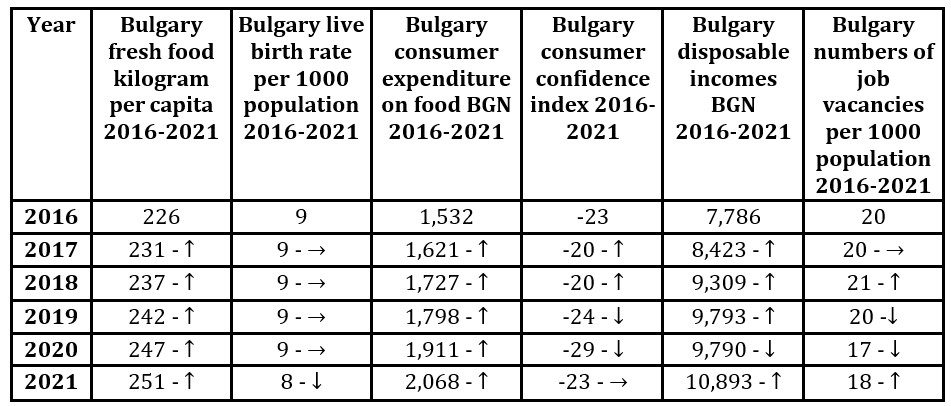
Source: processing of Euromonitor International Ltd., n.d.
After performing the Spearman correlation, two significant results were found, see Figure 1.
The first significant result is that the variable consumption of fresh food products from 2016 to 2021 has been correlated with the consumer expenditure on food.
The correlation has been obtained result +1, and it means a perfect correlation.
The second significant result is that the variable consumption of fresh food products from 2016 to 2021 has been correlated with the disposable incomes.
The correlation has been obtained the value +,0.943, and it means a strong correlation.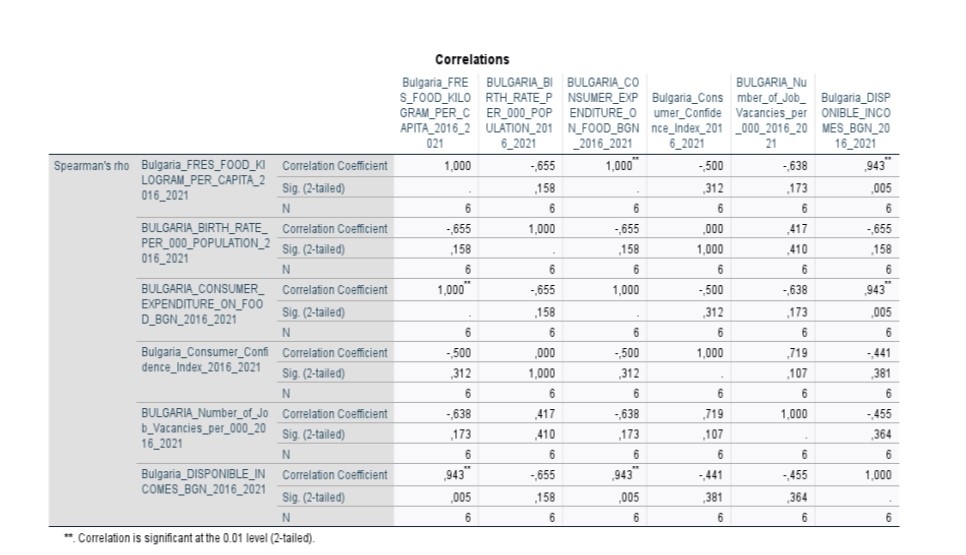
Figure 1: The results of Spearman correlation for Bulagary
Source: the author’s own research and processing
For Hungary, we have the following variables, see Table III:
Table III – The dependent variable and the independent variables from Hungary
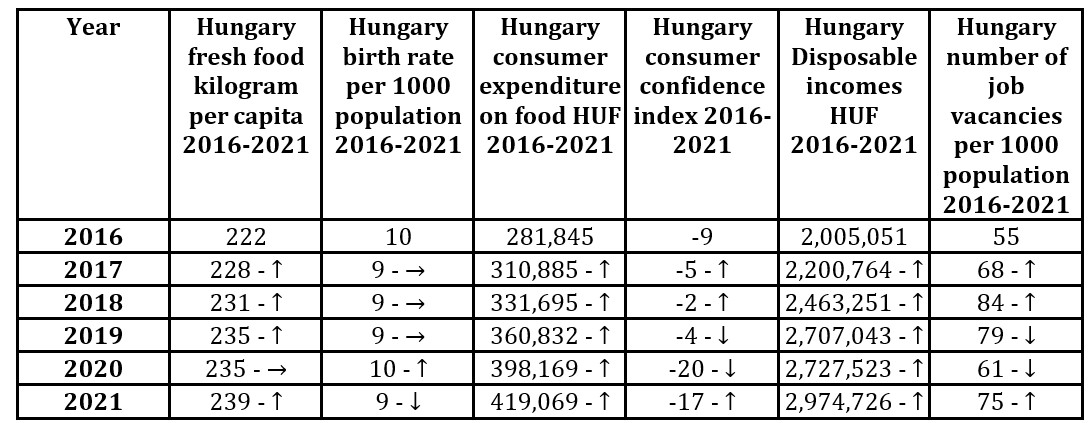
Source: processing of Euromonitor International Ltd., n.d.
After performing the Spearman correlation, two significant results were found, see Figure 2:
The first significant result is that the variable consumption of fresh food products from 2016 to 2021 has been correlated with the consumer expenditure.
The correlation has been obtained the result +0.986, and it means a strong correlation.
The second significant result is that the variable consumption of fresh food products from 2016 to 2021 has been correlated with the disposable incomes.
The correlation has been obtained the value of +,0.986, and it means a strong correlation.
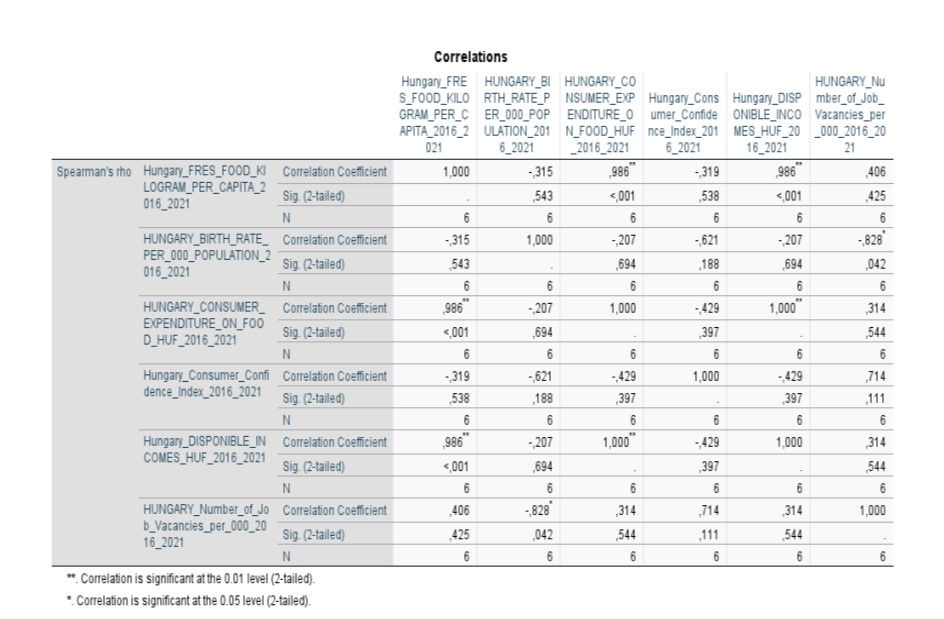
Figure 2: The results of Spearman correlation for Hungary
Source: the author’s own research and processing
For Romania, we have the following variables, see Table IV:
Table IV – The dependent variable and the independent variables from Romania:

Source: processing of Euromonitor International Ltd., n.d.
After performing the Spearman correlation, two significant results were found, see Figure 3.
The first significant result is that the variable consumption of fresh food products from 2016 to 2021 has been correlated with the consumer expenditure.
The correlation has been obtained the result +0.943, and it means a strong correlation.
The second significant result is that the variable consumption of fresh food products from 2016 to 2021 has been correlated with the disposable incomes.
The correlation has been obtained the value of +1, and it means a perfect correlation.
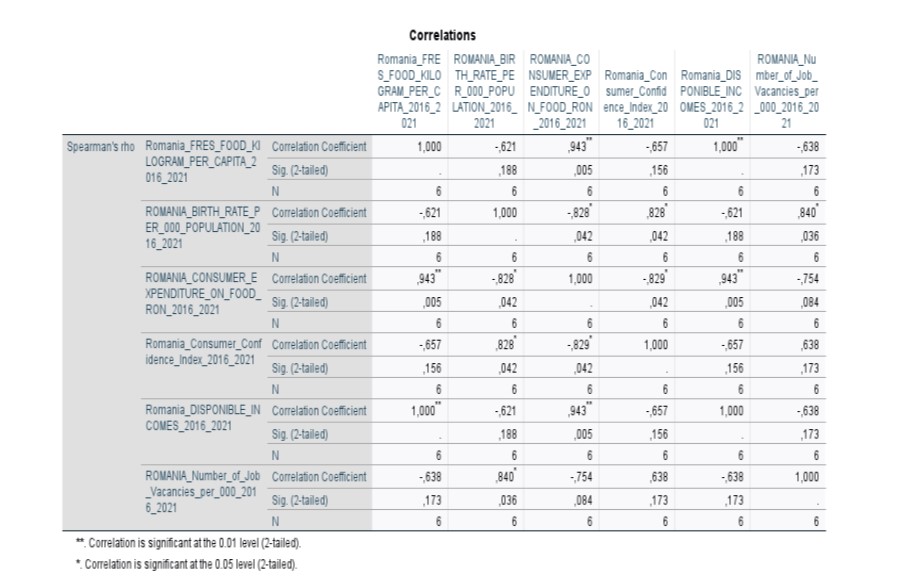
Figure 3: The results of Spearman correlation for Romania
Source: the author’s own research and processing
Bulgary, Romania and Hungary had significant results for the same variables, see Table V. Significant correlations between variables being high or perfect correlations.
Table V – Significant results of correlation

Source: the author’s own research and processing
What made these correlations significant?
If we look at the consumption of fresh food products kilogram per person 2016-2021 in each country, Bulgary, Hungary, and Romania, (see, Table VI), we can observe that it has increased every year in almost all countries. Of course there were two exceptions*, but these exceptions did not impact the results that much.
Table VI – Consumption of fresh food products kilogram per person 2016-2021 in Bulgary, Hungary, and Romania

Source: processing of Euromonitor International Ltd., n.d.
I can conclude that the COVID-19 pandemic has affected the consumption of fresh food for a while, but temporarily, without long-term repercussions.
As for the variables significantly correlated with the fresh food consumption variable 2016- 2021, they were as follows, see Table VII:
Table VII – Significant results of correlation
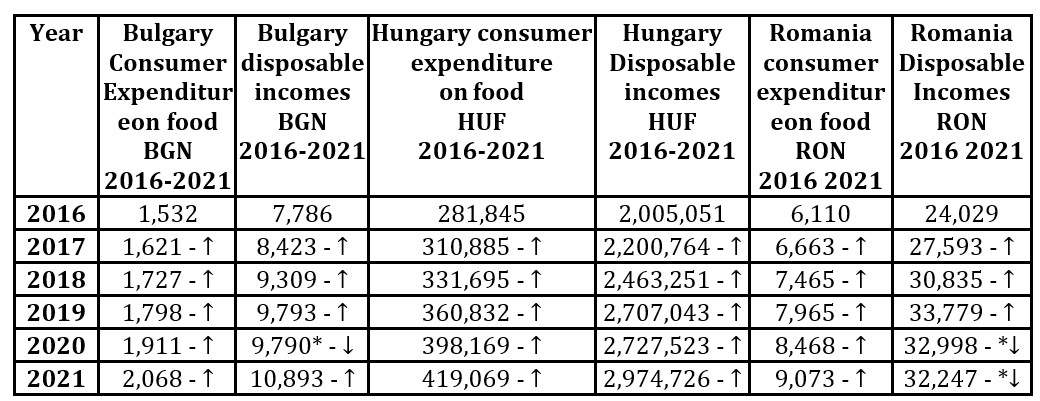
Source: processing of Euromonitor International Ltd., n.d.
It can be seen that the countries that studied the consumption of fresh food products between 2016-2021 were influenced by the same variables.
What do these results show us?
The variable, the consumption of fresh food products, is directly related to food expenditure and disposable income. Even though the COVID-19 pandemic seemed to affect the consumption of fresh food products to too high demand, but also due to decreases in consumer incomes, the effects of changing consumer behavior were positive in terms of increased consumption of fresh food products.
Conclusions
This article highlights the influence of economic and demographic factors on consumer behavior toward fresh produce before and during the COVID-19 pandemic.
It also outlines the variables influencing consumer behavior, the variable consumer expenditure on fresh food products per capita between 2016-2022, and the variable disposable income between 2016-2021.
As a result of this research, significant correlations had been obtained with the independent variables related to economic aspects (consumer expenditure on fresh food products per capita between 2016-2022 and disposable income between 2016-2021). These variables are also independent and dependent monetary variables.
The other variables that belong to the category of demographic factors (birth rate per 1000 persons between 2016-2021, consumer confidence index between 2016-2021, and the number of available jobs between 2016-2021) failed to obtain significant results from the correlations performed.
In future research on this topic, I would also like to investigate whether the consumer’s standard of living influences consumer behavior.
Also, the consumer’s consumption behavior towards fresh agricultural products in the year 2022 needs to be studied so that it can be seen if it is different from the pre-pandemic and pandemic period.
This consumer behavior in 2022 needs to be studied in order to be able to analyze whether consumers are behaving rationally and whether they are connected to the new realities they face; whether it is influenced by rational and/or emotional factors.
References
- Amalia, P., Ionut, P., 2009. CONSUMERS’ REACTION AND ORGANIZATIONAL RESPONSE IN CRISIS CONTEXT. Ann. Fac. Econ. 4, 779–782.
- Baker, D., Refsgaard, K., 2007. Institutional development and scale matching in disaster response management. Ecol. Econ. Coast. Disasters 63, 331–343. https://doi.org/10.1016/j.ecolecon.2007.01.007
- Balaure, n.d. Marketing – ediția a II-a revăzută și adăugită.
- Cătoiu, I., Bălan, C., Popescu, I.C., Orzan, G., Vegheș, C., Dănețiu, T., Vrânceanu, D., 2009. Cercetări de marketing -TRATAT-. Uranus, București.
- Constantin, M., 2007. Marketingul producției agroalimentare – Tratat. Agrotehnica, București.
- Dholakia, U., n.d. Why Are We Panic Buying During the Coronavirus Pandemic? | Psychology Today [WWW Document]. URL https://www.psychologytoday.com/intl/blog/the-science-behind-behavior/202003/why-are-we-panic-buying-during-the-coronavirus-pandemic (accessed 2.7.22).
- Diaconescu, M., 2016. Marketing Agroalimentar. Universitară, București.
- Duquenne, M.N., Vlontzos, G., 2014. The impact of the Greek crisis on the consumers’ behaviour: Some initial evidences? Br. Food J. 116. https://doi.org/10.1108/BFJ-11-2012-0279
- Durra, M., Jalal, A., 2010. The Global Business Crisis and Consumer Behavior: Kingdom of Bahrain as a Case Study. Int. J. Bus. Manag. 6. https://doi.org/10.5539/ijbm.v6n1p104
- Dutt, P., Padmanabhan, V., 2011. Crisis and Consumption Smoothing. Mark. Sci. 30, 491–512. https://doi.org/10.2139/ssrn.1419737
- Euromonitor International Ltd., n.d. Statistics Redesign | Passport [WWW Document]. URL https://www-portal-euromonitor-com.am.e-nformation.ro/portal/StatisticsEvolution/index (accessed 2.16.22).
- Filip, A., Voinea, L., 2011. Analyzing the Main Changes in New Consumer Buying Behavior during Economic Crisis. Int. J. Econ. Pract. Theor. 1, 14–19.
- Flatters, P., Willmott, M., 2009. Understanding the Post-Recession Consumer. Harv. Bus. Rev. 87, 106-+.
- Hansen, F., Percy, L., Hansen, M.H., 2004. Consumer choice behaviour: An emotional theory.
- Hasan, S., Islam, M.A., Bodrud-Doza, M., 2021. Crisis perception and consumption pattern during COVID-19: do demographic factors make differences? Heliyon 7, e07141–e07141. https://doi.org/10.1016/j.heliyon.2021.e07141
- Ngoc Long, N., Khoi, B., 2020. An Empirical Study about the Intention to Hoard Food during COVID-19 Pandemic. Eurasia J. Math. Sci. Technol. Educ. 16, 1857. https://doi.org/10.29333/ejmste/8207
- Nistorescu, T., Puiu, S., 2009. Marketing strategies used in crisis – study case. Univ. Libr. Munich Ger. MPRA Pap.
- Petrescu, E.-C., 2008. Marketing concepte de bază și aplicații. Uranus, București.
- Solomon, M.R., Russell-Bennett, R., Previte, J., 2013. Consumer behaviour: buying, having, being. Pearson Australia, Frenchs Forest, N.S.W.
- Su, X., 2010. Intertemporal Pricing and Consumer Stockpiling. Oper. Res. 58, 1133–1147. https://doi.org/10.1287/opre.1090.0797
- Theodoridou, G., Tsakiridou, E., Kalogeras, N., Mattas, K., 2017. Food Consumption Patterns in Times of Economic Recession. Int. J. Food Beverage Manuf. Bus. Models 2, 56–69. https://doi.org/10.4018/IJFBMBM.2017010105
- Vázquez-Martínez, U.J., Morales-Mediano, J., Leal-Rodríguez, A.L., 2021. The impact of the COVID-19 crisis on consumer purchasing motivation and behavior. Eur. Res. Manag. Bus. Econ. 27, 100166–100166. https://doi.org/10.1016/j.iedeen.2021.100166
- Vernerová, D., 2021. Impact of The Pandemic COVID-19 on Consumer Shopping Behaviour in Slovakia, in: 21st International Joint Conference Central and Eastern Europe in the Changing Business Environment : Proceedings. Presented at the 21st International Joint Conference Central and Eastern Europe in the Changing Business Environment : Proceedings, University of Economics in Bratislava, Vydavateľstvo EKONÓM. https://doi.org/10.18267/pr.2021.krn.4816.21
- Wang, E., An, N., Gao, Z., Kiprop, E., Geng, X., 2020. Consumer food stockpiling behavior and willingness to pay for food reserves in COVID-19. Food Secur. 12, 739–747. https://doi.org/10.1007/s12571-020-01092-1
- Wiloso, A.R., Purniawan, A.H., Susanti, D., Sughesti, D., Juliastuti, S., 2021. Sustainable Consumer Behavior: A Review. HUMANIS Humanit. Manag. Sci. Proc. 2.
- Yegbemey, R.N., Komlan Ahihou, C.M., Olorunnipa, I., Benali, M., Afari-Sefa, V., Schreinemachers, P., 2021. COVID-19 Effects and Resilience of Vegetable Farmers in North-Western Nigeria. Agronomy 11. https://doi.org/10.3390/agronomy11091808















